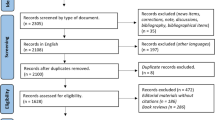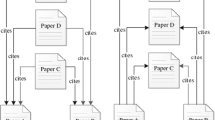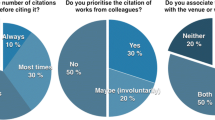Abstract
There has been an increase in research published on information behavior in recent years, and this has been accompanied by an increase in its diversity and interaction with other fields, particularly information retrieval. The aims of this study are to determine which researchers have contributed to producing the current body of knowledge on this subject, and to describe its intellectual basis. A bibliometric and network analysis was applied to authorship and co-authorship as well as citation and co-citation. According to these analyses, there is a small number of authors who can be considered to be the most productive and who publish regularly, and a large number of transient ones. Other findings reveal a marked predominance of theoretical works, some examples of qualitative methodology that originate in other areas of social science, and a high incidence of research focused on the user interaction with information retrieval systems and the information behavior of doctors.




Similar content being viewed by others
References
Abbasi, A., Hossain, L., & Leydesdorff, L. (2012). Betweenness centrality as a driver of preferential attachment in the evolution of research collaboration networks. Journal of Informetrics, 6(3), 403–412. doi:10.1016/j.joi.2012.01.002.
Alhaji, T. (2012). Exploring the relationship between research in information retrieval and information seeking behavior, 1979–2008. Vancouver: University of British Columbia.
Badar, K., Hite, J. M., & Badir, Y. F. (2013). Examining the relationship of co-authorship network centrality and gender on academic research performance: The case of chemistry researchers in Pakistan. Scientometrics, 94(2), 755–775. doi:10.1007/s11192-012-0764-z.
Bandura, A. (1986). Social foundations of thought and action: A social cognitive theory. Englewood Cliffs: Prentice-Hall.
Barry, C. L. (1994). User-defined relevance criteria: An exploratory study. Journal of the American Society for Information Science, 45(3), 149–159. doi:10.1002/(SICI)1097-4571(199404)45:3<149:AID-ASI5>3.0.CO;2-J.
Batagelj, V., & Mrvar, A. (2003). Pajek. Analysis and visualization of large networks. In M. Jünger & P. Mutzel (Eds.), Graph drawing software (pp. 77–103). Berlin: Springer.
Bates, M. J. (1989). The design of browsing and berrypicking techniques for the online search interface. Online review, 13(5), 407–424. doi:10.1108/eb024320.
Bilal, D. (2000). Children’s use of the Yahooligans! Web search engine. I. Cognitive, physical, and affective behaviors on fact-based search tasks. Journal of the American Society for Information Science, 51(7), 646–665. doi:10.1002/(SICI)1097-4571(2000)51:7<646:AID-ASI7>3.0.CO;2-A.
Borgman, C. L., Hirsh, S. G., Walter, V. A., & Gallagher, A. L. (1995). Children’s searching behavior on browsing and keyword online catalogs. The science library catalog project. Journal of the American Society for Information Science, 46(9), 663–684. doi:10.1002/(SICI)1097-4571(199510)46:9<663:AID-ASI4>3.0.CO;2-2.
Broder, A. (2002). A taxonomy of web search. ACM SIGIR Forum, 36(2), 3–10. doi:10.1145/792550.792552.
Case, D. O. (2012). Looking for information. A survey of research on information seeking, needs, and behavior (3rd ed.). Bingley: Emerald.
Case, D. O., & Higgins, G. M. (2000). How can we investigate citation behavior? A study of reasons for citing literature in communication. Journal of the American Society for Information Science, 51(7), 635–645.
Chang, Y.-W. (2011). A comparative study of the research literature on information needs and information seeking: A bibliometric and social network analysis. Journal of Educational Media and Library Sciences, 48(3), 347–380.
Chatman, E. A. (1996). The impoverished life-world of outsiders. Journal of the American Society for Information Science, 47(3), 193–206.
Chatman, E. A. (1999). A theory of life in the round. Journal of the American Society for Information Science, 50(3), 207–217.
Choo, C. W., Detlor, B., & Turnbull, D. (2000). Information seeking on the web: An integrated model of browsing and searching. First Monday, 5(2). Retrieved from http://firstmonday.org/ojs/index.php/fm/article/view/729.
Covell, D. G., Uman, G. C., & Manning, P. R. (1985). Information needs in office practice: Are they being met? Annals of Internal Medicine, 103(4), 596–599.
Cox, A. M. (2012). An exploration of the practice approach and its place in information science. Journal of Information Science, 38(2), 176–188. doi:10.1177/0165551511435881.
Davenport, E. (2010). Confessional methods and everyday life information seeking. Annual Review of Information Science and Technology, 44, 533–562. doi:10.1002/aris.2010.1440440119.
Davis, F. D. (1989). Perceived usefulness, perceived ease of use, and user acceptance of information technology. MIS Quarterly, 13(3), 319–340. doi:10.2307/249008.
Dervin, B., & Nilan, M. (1986). Information needs and uses. Annual Review of Information Science and Technology, 21, 3–33.
Ellis, D. (2011). The emergence of conceptual modelling in information behaviour research. In A. Spink & J. Heinström (Eds.), New directions in information behaviour (Vol. 1, pp. 17–35). Bingley: Emerald Group Publishing. doi:10.1108/S1876-0562(2011)002011a005.
Fidel, R., Davies, R. K., Douglass, M. H., Holder, J. K., Hopkins, C. J., Kushner, E. J., et al. (1999). A visit to the information mall: Web searching behavior of high school students. Journal of the American Society for Information Science, 50(1), 24–37. doi:10.1002/(SICI)1097-4571(1999)50:1<24:AID-ASI5>3.0.CO;2-W.
Fishbein, M., & Ajzen, I. (1975). Belief, attitude, intention, and behavior: An introduction to theory and research. Reading: Addison Wesley.
Fisher, K. E., Erdelez, S., & McKechnie, L. E. (Eds.). (2005). Theories of information behavior (pp. xix–xxii). Medford: Information Today.
Fisher, K. E., & Julien, H. (2011). Information behavior. Annual Review of Information Science and Technology, 43, 1–73. doi:10.1002/aris.2009.1440430114.
Fornell, C., & Larcker, D. F. (1981). Evaluating structural equation models with unobservable variables and measurement error. Journal of Marketing Research, 18(1), 39–50. doi:10.2307/3151312.
Freeman, L. C. (1979). Centrality in social networks conceptual clarification. Social Networks, 3(1), 215–239. doi:10.1016/0378-8733(78)90021-7.
Glaser, B. G., & Strauss, A. L. (1967). The discovery of grounded theory. Strategies for qualitative research. Chicago: Aldine De Gruyter.
Gmür, M. (2003). Co-citation analysis and the search for invisible colleges: A methodological evaluation. Scientometrics, 57(1), 27–57.
González-Teruel, A., & Abad García, M.-F. (2012). Grounded theory for generating theory in the study of information behavior. Library and Information Science Research, 34(1), 31–36. doi:10.1016/j.lisr.2011.02.006.
Gorman, P. N. (1995). Information needs of physicians. Journal of the American Society for Information Science, 46(10), 729–736.
Granovetter, M. S. (1973). The strength of weak ties. American Journal of Sociology, 78(6), 1360–1380.
Houston, R. D. (2009). A model of compelled nonuser of information. University of Texas at Austin, Unpublished doctoral dissertation.
Ingwersen, P. (1996). Cognitive perspectives of information retrieval interaction: Elements of a cognitive IR theory. Journal of Documentation, 52(1), 3–50. doi:10.1108/eb026960.
Ingwersen, P., & Järvelin, K. (2005). The turn. integration of information seeking and retrieval in context (pp. 1–455). Springer: Berlin.
Ioannidis, J. P. A., Boyack, K. W., & Klavans, R. (2014). Estimates of the continuously publishing core in the scientific workforce. PLoS One, 9(7), e101698. doi:10.1371/journal.pone.0101698.s004.
Jamali, H. R. (2013). Citation relations of theories of human information behaviour. Webology, 10(1). Retrieved from http://www.webology.org/2013/v10n1/a106.html
Julien, H. (1996). A Content Analysis of the Recent Information Needs and Uses Literature. Library and Information Science Research, 18, 53–65.
Julien, H., & Duggan, L. J. (2000). A longitudinal analysis of the information needs and uses literature. Library and Information Science Research, 22(3), 291–309.
Julien, H., Given, L. M., & Opryshko, A. (2013). Photovoice: A promising method for studies of individuals’ information practices. Library and Information Science Research, 35(4), 257–263. doi:10.1016/j.lisr.2013.04.004.
Julien, H., Pecoskie, J., & Reed, K. (2011). Trends in information behavior research, 1999–2008: A content analysis. Library and Information Science Research, 33(1), 19–24. doi:10.1016/j.lisr.2010.07.014.
Kelly, D., & Sugimoto, C. R. (2013). A systematic review of interactive information retrieval evaluation studies, 196–2006. Journal of the American Society for Information Science and Technology, 64(4), 745–770. doi:10.1002/asi.22799.
Knoke, D., & Yang, S. (2008). Social network analysis (2nd ed.). Thousands Oaks: Sage.
Krikelas, J. (1983). Information-seeking behavior: Patterns and concepts. Drexel Library Quarterly, 19(2), 5–20.
Kuhlthau, C. C. (1991). Inside the search process: Information seeking from the user’s perspective. Journal of the American Society for Information Science, 42(5), 361–371.
Kuhlthau, C. C. (1993). Seeking Meaning: A process approach to library and information services. Norwood: Ablex.
Kuhlthau, C. C. (2004). Seeking meaning: A process approach to library and information services (2nd ed.). Westport: Libraries Unlimited.
Larivière, V., Sugimoto, C. R., & Cronin, B. (2012). A bibliometric chronicling of library and information science’s first hundred years. Journal of the American Society for Information Science and Technology, 63(5), 997–1016. doi:10.1002/asi.22645.
Lazonder, A. W., Biemans, H. J., & Wopereis, I. G. (2000). Differences between novice and experienced users in searching information on the World Wide Web. Journal of the American Society for Information Science, 51(6), 576–581. doi:10.1002/(SICI)1097-4571(2000)51:6<576:AID-ASI9>3.0.CO;2-7.
Lee, D., Goh, K. I., Kahng, B., & Kim, D. (2010). Complete trails of coauthorship network evolution. Physical Review E, 82(2), 026112. doi:10.1103/PhysRevE.82.026112.
Li-Ping, K. (2010). Introduction to information seeking behavior. A review of literature and field practice directions. Chinese Journal of Library and Information Science, 3(1), 65–78.
Liu, X., Bollen, J., Nelson, M. L., & Van de Sompel, H. (2005). Co-authorship networks in the digital library research community. Information Processing and Management, 41(6), 1462–1480. doi:10.1016/j.ipm.2005.03.012.
Marchionini, G. (1989). Information-seeking strategies of novices using a full-text electronic encyclopedia. Journal of the American Society for Information Science, 40(1), 54–66.
McKechnie, L. E., Baker, L., Greenwood, M., & Julien, H. (2002). Research method trends in human information literature. The New Review of Information Behaviour Research, 3, 113–125.
McKechnie, L. E., Goodall, G. R., Lajoie-Paquette, D., & Julien, H. (2005). How human information behaviour researchers use each other’s work: A basic citation analysis study. Information Research, 10(2). Retrieved from http://www.informationr.net/ir/10-2/paper220.html
McKechnie, L. E., Pettigrew, K. E., & Joyce, S. L. (2001). The origins and contextual use of theory in human information behaviour research. The New Review of Information Behaviour Research, 2, 47–63.
McKenzie, P. J. (2003). A model of information practices in accounts of everyday-life information seeking. Journal of Documentation, 59(1), 19–40. doi:10.1108/00220410310457993.
Milojević, S., Sugimoto, C. R., Yan, E., & Ding, Y. (2011). The cognitive structure of library and information science: Analysis of article title words. Journal of the American Society for Information Science and Technology, 62(10), 1933–1953. doi:10.1002/asi.21602.
Mizzaro, S. (1997). Relevance: The whole history. Journal of the American Society for Information Science, 48(9), 810–832.
Newman, M. E. J. (2004). Who is the best connected scientist? A study of scientific coauthorship networks. Complex Networks Lecture Notes in Physics, 650, 337–370.
Olsson, M. R. (2006). Beyond “needy” individuals: Conceptualizing information behavior. Proceedings of the American Society for Information Science and Technology, 42(1), 43–55. doi:10.1002/meet.1450420161.
Olsson, M. R. (2012). Ciphers to this great accompt. The Shakespearian Social Sense-Making of theatre professionals. In G. Widén-Wulff & K. Holmberg (Eds.), Social information research (Vol. 5, pp. 17–42). Bingley: Emerald. doi:10.1108/S1876-0562(2012)0000005004.
Palmquist, R. A., & Kim, K. S. (2000). Cognitive style and on-line database search experience as predictors of web search performance. Journal of the American Society for Information Science, 51(6), 558–566. doi:10.1002/(SICI)1097-4571(2000)51:6<558:AID-ASI7>3.0.CO;2-9.
Persson, O. (1994). The intellectual base and research fronts of JASIS 1986–1990. Journal of the American Society for Information Science, 45(1), 31–38.
Persson, O., Danell, R., & Schneider, J. W. (2009). How to use Bibexcel for various types of bibliometric analysis. In F. Åström, R. Danell, B. Larsen, & J. W. Schneider (Eds.), Celebrating scholarly communication studies: A Festschrift for Olle Persson at his 60th Birthday. Leuven: International Society for Scientometrics and Informetrics.
Pettigrew, K. E. (1999). Waiting for chiropody: Contextual results from an ethnographic study of the information behaviour among attendees at community clinics. Information Processing and Management, 35(6), 801–817. doi:10.1016/S0306-4573(99)00027-8.
Pirolli, P., & Card, S. K. (1999). Information foraging. Psychological Review, 106, 642–675.
Rasmussen, J., Pejtersen, A. M., & Goodstein, L. P. (1994). Cognitive systems engineering. New York: Wiley.
Rieh, S. Y. (2002). Judgment of information quality and cognitive authority in the Web. Journal of the American Society for Information Science and Technology, 53(2), 145–161. doi:10.1002/asi.10017.
Saracevic, T. (1975). Relevance: A review of and a framework for the thinking on the notion in information science. Journal of the American Society for Information Science, 26(6), 321–343.
Savolainen, R. (1995). Everyday life information seeking: Approaching information seeking in the context of “Way of Life”. Library and Information Science Research, 17(3), 259–294.
Schubert, A., & Glänzel, W. (1991). Publications dynamics: Models and indicators. Scientometrics, 20(1), 317–331.
Sin, S.-C. J. (2011). International coauthorship and citation impact: A bibliometric study of six LIS journals, 1980–2008. Journal of the American Society for Information Science and Technology, 62(9), 1770–1783. doi:10.1002/asi.21572.
Spink, A., & Jansen, B. J. (2004). Web search: Public searching of the web. Dordrecht: Kluwer.
Strauss, A. L., & Corbin, J. (1990). Basics of qualitative research: Grounded theory procedures and techniques. Newbury Park: Sage.
Talja, S., Tuominen, K., & Savolainen, R. (2005). “Isms” in information science: Constructivism, collectivism and constructionism. Journal of Documentation, 61(1), 79–101. doi:10.1108/00220410510578023.
Taylor, R. S. (1991). Information use environments. In B. Dervin & M. J. Voigt (Eds.), Progress in communication sciences (pp. 217–255). Norwood: Ablex.
Tuominen, K. (1997). User-centered discourse: An analysis of the subject positions of the user and the librarian. Library Quarterly, 67(4), 350–371.
Vakkari, P. (2008). Trends and approaches in information behaviour research. Information Research, 13(4). Retrieved from http://www.informationr.net/ir/13-4/paper361.html
Wang, P., Berry, M. W., & Yang, Y. (2003). Mining longitudinal web queries: Trends and patterns. Journal of the American Society for Information Science and Technology, 54(8), 743–758.
Wang, P. L., & Soergel, D. (1998). A cognitive model of document use during a research project. Study I. document selection. Journal of the American Society for Information Science, 49(2), 115–133.
Wenger, E. (1998). Communities of practice: Learning, meaning, and identity. Cambridge: Cambridge University Press.
Williamson, K. (1998). Discovered by chance: The role of incidental information acquisition in an ecological model of information use. Library and Information Science Research, 20(1), 23–40.
Wilson, P. (1983). Second-hand knowledge. An inquiry into cognitive authority. Westport: Greenwood.
Wilson, T. D. (1999). Models in information behaviour research. Journal of Documentation, 55(3), 249–270.
Wilson, T. D. (2000). Human information behavior. Informing Science, 3(2), 49–56.
Wilson, T. D. (2008). The information user: Past, present and future. Journal of Information Science, 34(4), 457–464. doi:10.1177/0165551508091309.
Wilson, T. D. (Ed.). (2013). Theory in information behaviour research. Sheffield: Eiconics.
Wuchty, S., Jones, B. F., & Uzzi, B. (2007). The increasing dominance of teams in production of knowledge. Science, 316(5827), 1036–1039. doi:10.1126/science.1136099.
Yan, E., & Ding, Y. (2009). Applying centrality measures to impact analysis: A coauthorship network analysis. Journal of the American Society for Information Science and Technology, 60(10), 2107–2118. doi:10.1002/asi.21128.
Author information
Authors and Affiliations
Corresponding author
Rights and permissions
About this article
Cite this article
González-Teruel, A., González-Alcaide, G., Barrios, M. et al. Mapping recent information behavior research: an analysis of co-authorship and co-citation networks. Scientometrics 103, 687–705 (2015). https://doi.org/10.1007/s11192-015-1548-z
Received:
Published:
Issue Date:
DOI: https://doi.org/10.1007/s11192-015-1548-z




